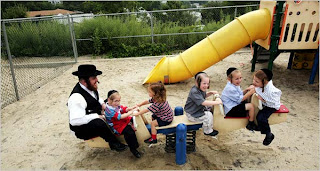Times runs an enormous feature by Jason DeParle on life in the universe in which marriage is the key variable ("Two Classes, Divided by 'I Do'") from which everything else follows; Ms. F and Ms. S, who work in the same day care center in Ann Arbor, Michigan, are practically the same person, but Ms. F is married and Ms. S is not, so naturally Ms. F finished college, became the boss, and has the time and money to give her children a spectacularly nurturing and yet stimulating environment to grow up in, while Ms. S dropped out, became the employee, and consigned her own kids to a life of sensory deprivation and food stamps.
In other words, it's a dispatch from Brooksland, where income inequality is caused by sluts who persist in giving it away for free, thus creating poverty in an otherwise pretty cushy little society. Hold out until you see that ring, girls! The poverty you don't create may be your own.
Or, as DeParle puts it,
So can you argue that abortion protects women from poverty? According to the Hudson Valley Times Herald-Record, January 2009, Kiryas Joel, New York, has the highest poverty rate in the nation (68%), as well as the highest marriage rate (80% of women ages 15 to 30). No information is given about the abortion rate, but believe me, there is not much abortion in KJ. But the number of places where you can predict the abortion rate without doing any research is vanishingly small.
What you could probably argue is that early childbirth—let's say, when the woman is 21 or under—contributes to poverty, and that abortion, where available, would help counteract it. Given the decrease in available abortion over how many years it's been, maybe that would account for a reasonable amount of the poverty.
Still more effective than abortion, of course, would be normal reliable contraception methods, made universally available to young women, but there'd be all kinds of moral hazard in that, wouldn't there? I mean, compared to the quiet benevolence with which our elites cut back on their food stamps and after-school programs and write spiteful newspaper columns about them.
In other words, it's a dispatch from Brooksland, where income inequality is caused by sluts who persist in giving it away for free, thus creating poverty in an otherwise pretty cushy little society. Hold out until you see that ring, girls! The poverty you don't create may be your own.
 |
| Girl, Appalachian house. From America Watch. |
scholars have said that changes in marriage patterns — as opposed to changes in individual earnings — may account for as much as 40 percent of the growth in certain measures of inequality. Long a nation of economic extremes, the United States is also becoming a society of family haves and family have-nots, with marriage and its rewards evermore [sic, but I think it should be "ever more"] confined to the fortunate classes.However, I don't think those scholars are necessarily counting all the variables.
Although she grew up in the 1990s, Ms. Schairer’s small-town childhood had a 1950s feel. Her father drove a beer truck, her mother served as church trustee and her grandparents lived next door. She knew no one rich, no one poor and no one raising children outside of marriage. “It was just the way it was,” she said.
One big variable jumps out at me from that paragraph, and I'm not even talking about the boyfriend's race (Schairer herself, judging from the pictures and the fact that it's not mentioned anywhere in the article, is white): abortion. You can't say if she had had that abortion she would have finished college, broken up with the jerk sooner, qualified for a better job, had children eventually from a more secure position, and so forth, but all these things would have been much easier, obviously.William Penn University, eight hours away in Iowa, offered a taste of independence and a spot on the basketball team. Her first thought when she got pregnant was “My mother’s going to kill me.” Abortion crossed her mind, but her boyfriend, an African-American student from Arkansas, said they should start a family. They agreed that marriage should wait until they could afford a big reception and a long gown.
So can you argue that abortion protects women from poverty? According to the Hudson Valley Times Herald-Record, January 2009, Kiryas Joel, New York, has the highest poverty rate in the nation (68%), as well as the highest marriage rate (80% of women ages 15 to 30). No information is given about the abortion rate, but believe me, there is not much abortion in KJ. But the number of places where you can predict the abortion rate without doing any research is vanishingly small.
What you could probably argue is that early childbirth—let's say, when the woman is 21 or under—contributes to poverty, and that abortion, where available, would help counteract it. Given the decrease in available abortion over how many years it's been, maybe that would account for a reasonable amount of the poverty.
Still more effective than abortion, of course, would be normal reliable contraception methods, made universally available to young women, but there'd be all kinds of moral hazard in that, wouldn't there? I mean, compared to the quiet benevolence with which our elites cut back on their food stamps and after-school programs and write spiteful newspaper columns about them.
 |
| Pre-K teacher Chaim Schwarz of Kiryas Joel. New York Times. |